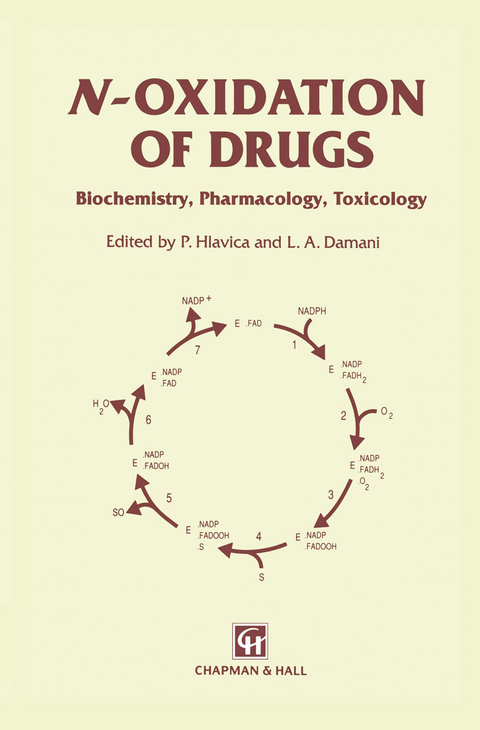
N-Oxidation of Drugs
Springer (Verlag)
978-94-010-5378-5 (ISBN)
Thus, detailed account is given of the mechanism and substrate specificity of the flavin-containing mono- oxygenase and factors regulating its activity are addressed. A separate chapter outlines the polymorphic expression of flavoprotein-dependent reactions. Similarly, the mechanistic background and inducibility of cytochrome P-450-catalysed turnover of specific types of nitrogenous compounds is highlighted. Data are also compiled describing the role of peroxidative N-oxidation of xenobiotics in extrahepatic tissues lacking significant amounts ofcytochrome P-450.
One Analysis of N-Oxidized Products.- 1 Formation of aromatic amine free radicals by prostaglandin hydroperoxidase and peroxyl radicals: analysis by ESR and stable end products.- 2 The application of 15N-NMR in the analysis of N-oxygenated amidines and guanidines.- 3 Radioimmunoassay and other methods for trace analysis of N-oxide compounds.- Two Enzymology of N-Oxidation.- 4 Mechanism, multiple forms and substrate specificities of flavincontaining mono-oxygenases.- 5 On the genetic polymorphism of the flavin-containing monooxygenase.- 6 Factors regulating the activity of the rabbit lung flavincontaining mono-oxygenase.- 7 Human pharmacogenetics of nitrogen oxidations.- 8 Microbial N-hydroxylases.- 9 Roles of aminium radical intermediates in the biotransformation of dihydropyridines, cycloalkylamines, and N,N-dimethylanilines by cytochrome P-450 enzymes.- 10 The role of cytochrome P-450 in the biological nuclear N-oxidation of aminoazaheterocyclic drugs and related compounds.- 11 New aspects of the microsomal N-hydroxylation of benzamidines.- 12 Studies on the N-oxidation of phentermine: evidence for an indirect pathway of N-oxidation mediated by cytochrome P-450.- 13 Molecular activation mechanisms involved in arylamine cytotoxicity: peroxidase products.- Three Reductions and Conjugations of N-Oxygenated Compounds.- 14 Reduction and conjugation reactions of N-oxides.- 15 In vivo metabolism of N-oxides.- 16 Purification and characterization of rat hepatic acetyltransferase.- Four Bioactivation of Nitrogenous Compounds and Cell Toxicity.- 17 Metabolism and activation of nitrosamines catalysed by cytochrome P-450 isoenzymes.- 18 Cytochrome P-450-catalysed activation of carcinogenic aromatic amines and amides.- 19 Comparative biochemistry of cytochrome P-450 species responsible for the activation of mutagenic food-derived heterocyclic amines.- 20 Specificity and inducibility of cytochrome P-450 catalysing the activation of food-derived mutagenic heterocyclic amines.- 21 Monoamine oxidase-mediated activation of MPTP and related compounds.- 22 Activation of aromatic amines by oxyhaemoglobin.- 23 Relevance of primary and secondary nitroxide radicals in biological oxidations.- 24 Molecular approaches to evaluation of the risk of aromatic amineinduced bladder cancer: smoking related carcinogen-DNA adducts in biopsied samples of human urinary bladder.- 25 The role of N-oxidation by leukocytes in drug-induced agranulocytosis and other drug hypersensitivity reactions.- 26 Phototoxic effects of N-oxidized drugs and related compounds.
| Zusatzinfo | XX, 487 p. |
|---|---|
| Verlagsort | Dordrecht |
| Sprache | englisch |
| Maße | 155 x 235 mm |
| Themenwelt | Medizin / Pharmazie ► Medizinische Fachgebiete ► Pharmakologie / Pharmakotherapie |
| Medizin / Pharmazie ► Pharmazie | |
| Studium ► 2. Studienabschnitt (Klinik) ► Pharmakologie / Toxikologie | |
| Naturwissenschaften ► Biologie ► Biochemie | |
| ISBN-10 | 94-010-5378-2 / 9401053782 |
| ISBN-13 | 978-94-010-5378-5 / 9789401053785 |
| Zustand | Neuware |
| Haben Sie eine Frage zum Produkt? |
aus dem Bereich


